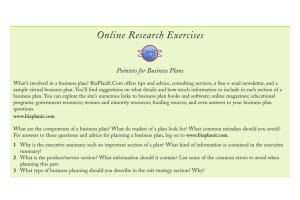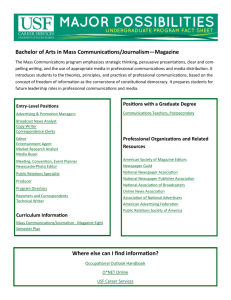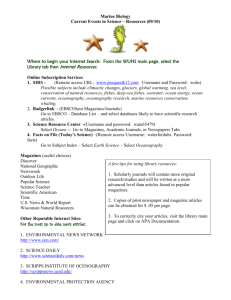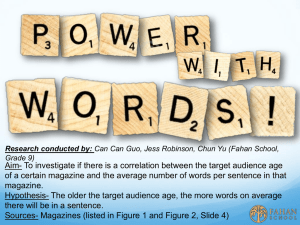THE MAGAZINE WRITER'S "OTHER WORLD"
advertisement
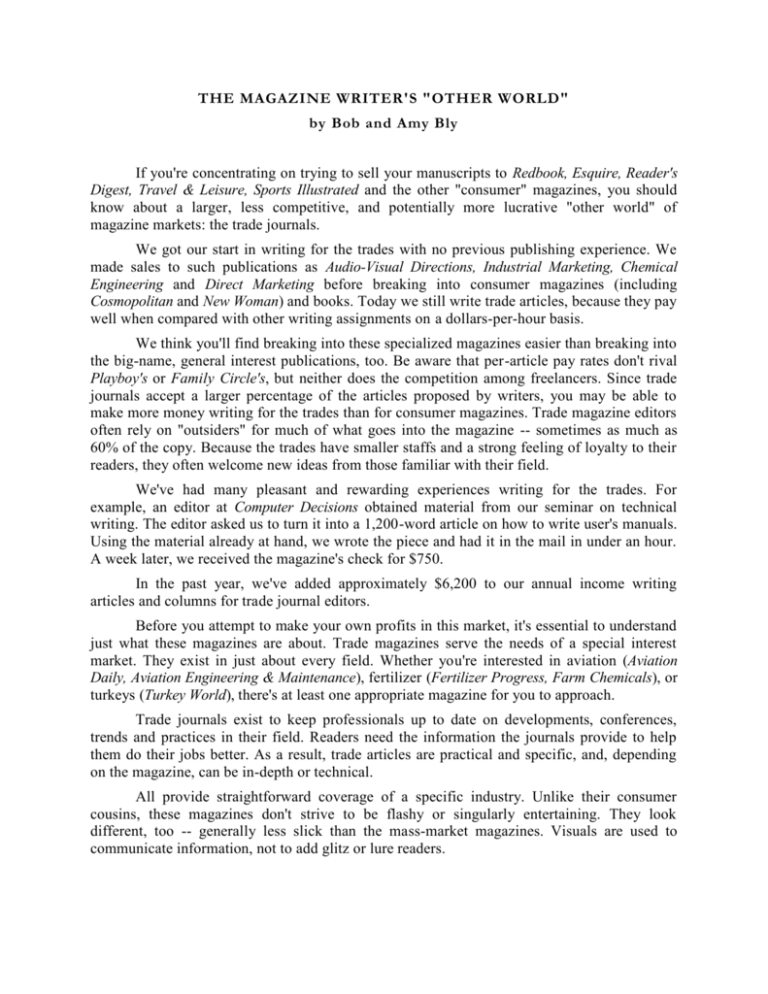
THE MAGAZINE WRITER'S "OTHER WORLD" by Bob and Amy Bly If you're concentrating on trying to sell your manuscripts to Redbook, Esquire, Reader's Digest, Travel & Leisure, Sports Illustrated and the other "consumer" magazines, you should know about a larger, less competitive, and potentially more lucrative "other world" of magazine markets: the trade journals. We got our start in writing for the trades with no previous publishing experience. We made sales to such publications as Audio-Visual Directions, Industrial Marketing, Chemical Engineering and Direct Marketing before breaking into consumer magazines (including Cosmopolitan and New Woman) and books. Today we still write trade articles, because they pay well when compared with other writing assignments on a dollars-per-hour basis. We think you'll find breaking into these specialized magazines easier than breaking into the big-name, general interest publications, too. Be aware that per-article pay rates don't rival Playboy's or Family Circle's, but neither does the competition among freelancers. Since trade journals accept a larger percentage of the articles proposed by writers, you may be able to make more money writing for the trades than for consumer magazines. Trade magazine editors often rely on "outsiders" for much of what goes into the magazine -- sometimes as much as 60% of the copy. Because the trades have smaller staffs and a strong feeling of loyalty to their readers, they often welcome new ideas from those familiar with their field. We've had many pleasant and rewarding experiences writing for the trades. For example, an editor at Computer Decisions obtained material from our seminar on technical writing. The editor asked us to turn it into a 1,200-word article on how to write user's manuals. Using the material already at hand, we wrote the piece and had it in the mail in under an hour. A week later, we received the magazine's check for $750. In the past year, we've added approximately $6,200 to our annual income writing articles and columns for trade journal editors. Before you attempt to make your own profits in this market, it's essential to understand just what these magazines are about. Trade magazines serve the needs of a special interest market. They exist in just about every field. Whether you're interested in aviation (Aviation Daily, Aviation Engineering & Maintenance), fertilizer (Fertilizer Progress, Farm Chemicals), or turkeys (Turkey World), there's at least one appropriate magazine for you to approach. Trade journals exist to keep professionals up to date on developments, conferences, trends and practices in their field. Readers need the information the journals provide to help them do their jobs better. As a result, trade articles are practical and specific, and, depending on the magazine, can be in-depth or technical. All provide straightforward coverage of a specific industry. Unlike their consumer cousins, these magazines don't strive to be flashy or singularly entertaining. They look different, too -- generally less slick than the mass-market magazines. Visuals are used to communicate information, not to add glitz or lure readers. CHOOSING A TRADE Your first step to writing for the trades is to decide which journals interest you, and which match your background and writing capabilities. You don't need industry experience or an engineering degree to write about most subjects covered by the trades, but you will have to know how to research and interview. In our case, Amy has no technical background (she majored in French and Russian), while Bob has a bachelor's degree in chemical engineering. We find that our backgrounds don't affect our ability to turn out clear, comprehensible trade articles on a wide variety of topics. Amy has written about such diverse subjects as meat packing, printing, health insurance, strategic planning, prefabricated metal buildings and public relations. Bob has published numerous articles outside his chemical engineering specialty, including pieces on semiconductors, aerospace, defense and computer software. Since more than 6,000 trade journals are published, you must zero in on the publications that are appropriate markets for you. First, list subjects you're interested in writing about. Then, search Bacon's Publicity Checker, the Business Publications edition of SRDS (Standard Rate and Data Service) or Writer's Market for listings of trade journals that cover these topics. (These books are available at your local library.) Bacon's and SRDS contain the most listings, but Writer's Market provides a more detailed description of each journal's editorial requirements. Then request sample copies of trade magazines that relate to the subjects you listed. In studying these issues, see what kinds of stories the editor uses and note their degree of technical difficulty. Determine whether these pieces are written by staff writers, outside technical experts or freelance writers. (Check article bylines against the masthead's list of staff writers or read the author bios printed with articles.) Most trade editors combine work from staff writers and freelancers. If every contributed article carries the byline of a chemist or an engineer and you are neither, querying the editor is probably a waste of time. Likewise if the material seems hopelessly technical to you. On the other hand, if you have an interest in, say, computers, but terms like asynchronous and ASCII are unfamiliar to you, a dictionary of computer jargon might be all you need to write an acceptable article. TYPES OF ARTICLES In studying your sample issues, you'll notice that trade journals commonly use eight types of articles. Not all magazines may buy every type, but understanding how each is constructed and what each tells readers will help you create salable ideas. Features are lengthy and in-depth articles addressing a specific problem, trend or development of interest to readers. The feature is the issue's main attraction and is generally supported by considerable research and interviews. For example, High Tech Marketing's feature story, "Are There Equal Rights in High-Tech?", included interviews with ten executive women and quoted the results of three relevant career and salary surveys. Industry roundups focus on a specific type of product important to readers' businesses. The roundup examines in depth the advantages and disadvantages of the various versions of the product, often mentioning specific manufacturers. One such article in Packaging highlighted various foam packaging products on the market and their applications. Case histories examine one company's experience with a product, service or new process or technology. They are shorter than features (usually one to two magazine pages with photos) and follow a problem-solution-results structure. One case history we wrote showed how super-absorbent meat pads increased sales and cut rewrapping time in a supermarket chain. Another told how a petrochemical company solved a costly underground oil leak problem using a management consultant's decision-making technique. The key factor that makes an article a case history is that the article tells how one company used another company's product or service. Tutorials, also known as how-tos, offer practical, specific tips on such topics as how to increase efficiency, control costs, maintain machinery, select equipment, save energy or prevent pollution. "Plotting Your Course" in Audio-Visual Directions told audio-visual producers about a new, more convenient format for writing, typing and revising scripts. Interviews profile an industry leader, trendsetter, "rising star" or professional who has solved an on-the-job problem or achieved outstanding success in the field. For instance, Computer Living ran an interview with Stephen Wozniak, co-founder of Apple Computer, Inc. Such pieces may be written in either Q&A (question-and-answer) or story format. Company profiles describe how a particular company has become successful. Though these tend to focus on the management style and philosophy of the company's president or top executives as revealed in interviews, they also examine key decisions and how the company faced problems. In Food in Canada magazine, "Golden Valley Builds on Total Market Base" told how a food processing firm grew from a company with two products to one with 82 different items and sizes. Sprinkled with quotes from the president of the company, the piece included a brief history, descriptions of new market ventures and products, its future sales plans, and a discussion of the company's conservative marketing approach. Unlike a case history, which is the story of the successful use of a single product in one specific application, the company profile is more far-reaching, covering the progress, development and growth of an entire firm. General management/business articles offer advice on general interest topics, such as time management, public speaking, writing and performance appraisals. These can be ideal articles for lay-authors because they require no specialized knowledge of the industry and are written from personal experience or library research. We wrote a series of nine articles for CPI 100 on such topics as "Improving Interpersonal Relationships," "How to Improve Your Presentation Skills" and "Sharpening Your Listening Skills." Essays present the writer’s personal opinion on an industry-related trend or issue. For example, Bob contributed a Perspectives column to Business Marketing magazine that said corporate marketing managers needed to be more sensitive and considerate in dealing with freelance writers and artists hired by their firms. Not every magazine presents these common article types in the same fashion. Note in your sample issues the tone, style and content favored by individual editors. To be able to pitch an idea effectively, you must familiarize yourself with the magazine by reading several issues to get a general feeling and to pinpoint their audience. An additional tool available to writers is the editorial calendar. Many trade journals annually plot the major issues to be covered in each issue throughout the year. Proposing a piece that ties in with a topic planned for a future issue can work to your advantage. "If people respond to our editorial calendar with ideas for specific issues, great," says Dunn. "Or, if they can provide background for a story we want to do, they'll have an edge in getting into the magazine." (Request a copy of a magazine's editorial calendar from the editor at the same time you send for sample issues.) GAINING EXPERIENCE Your ability to develop salable ideas may depend on your familiarity with the industry. Personal experience in a given trade may point you to potential articles for the appropriate journal. But there are many sources for those writers without previous work experience in the industry. Company marketing and public relations departments often will tip writers to newsworthy problems, technologies and overall trends. If you can establish a rapport with a person who works in an industry you plan to cover, pick his or her brain about special problems, new products, or new techniques. Contacts within companies also may direct you to their customers (who use their products) or to their public relations agency, if they have one. Since PR account executives live to promote their clients, they can be an excellent source, especially for case histories. All of these sources also can supply literature and background information. (O'Dwyer's Directory of Corporate Communications lists the names, addresses and phone numbers of public relations directors at 4,000 of the biggest US corporations and 1,000 of the top industry trade associations. O’Dwyer's Directory of Public Relations Firms can tell you the same information and the clients of more than 1,400 US public relations agencies. Both are published by J.R. O'Dwyer Co., 271 Madison Ave., New York City 10016, tel. 212/679-2471. Your library should have copies.) By asking these organizations to put you on their mailing lists, you can keep up with news in the field on a regular basis. Just write to the PR directors and explain that you're a journalist covering their industry. Inviting material from many sources will help develop industry roundup articles. Don't overlook newsletters, magazines, newspapers and TV as additional sources of ideas. Short items about business, industry and technology can serve as the starting points for full-length trade journal stories. For example, one of International Paper's well-known "Power of the Printed Word" series of advertisements gave us the idea for our "Improving Your Presentation Skills" article. Once editors know you and your work, they may come to you with article ideas. Many times, freelancers are asked to write monthly columns (with a guaranteed payment for each) for trade journals based on earlier work for the magazine. For example, based on a single article on how to write catalog copy, an editor asked us to contribute a regular column to a catalog marketing newsletter. LIKES AND DISLIKES Although trade journals may be a different "world" from consumer magazines, they are part of the same industry. Editors of trade publications treat writers exactly the same as consumer publication editors; similarly, the editors at Packaging, Modern Material Handling and Turkey World expect to be treated with the same respect you'd give the editor of Ladies' Home Journal or TV Guide. In querying editors of trade journals, there are two points that you'll want to stress more than you might in a proposal to a consumer magazine: Sources. If you're an expert in the field, fine. If not, you will need to interview qualified people and collect as much printed material as you can. Title, position and experience of your sources can demonstrate your professionalism and get your idea approved. For example, if you're writing a feature article on "How to Reduce Electrostatic Discharge Damage in the Manufacturing Plant," you probably would want to talk to production line supervisors, electrical engineers and packaging engineers. Other sources of information could include manufacturers of electrostatic discharge control materials, university researchers and industry trade association officials. To find these individuals, consult the O'Dwyer directories or, for the academic research labs, the PR directors of local colleges and universities. Photos. If you're writing about a product, the editor will probably want to run photos of it. If your article is a company profile, stating the availability of photos of the people you interview might help make the sale. Check Writer's Market or sample issues to find out which magazines use photos with stories. You don't have to be a professional photographer-color slides taken with a 35mm camera are acceptable to many publications. Other sources for photos are trade associations, companies and PR firms. It's after you've won an editor's approval that you'll discover the major differences between the worlds of consumer and trade magazines. Writing trade journal articles requires a different approach than writing for popular magazines. The following tips will help you produce articles that sell. Timelines and the informational value of a story are almost always more important than writing ability and style. Don't worry about catchy leads and clever phrases; instead, ask yourself, "Will what I'm writing be interesting, helpful and clear to the reader?" Here's the lead of "Ten Ways to Stretch Your Advertising Budget," a general business article published in Plastics Industry News, a magazine for advertising managers in the plastics industry. Note that the paragraph is factual and functional, not fancy: Most business-to-business advertisers have smaller ad budgets than their counterparts in consumer marketing. Here are ten ways to get more out of your advertising dollars-without detracting from the quality and quantity of your ads and promotions. In some cases, these ideas can even enhance the effectiveness of your marketing efforts. A clear, straightforward, logical presentation of the story is best. Trade journal readers are busy people; they read them not for entertainment but for the information that can help them. So make your article concise and to the point, as in this lead from a piece on "A New Approach to Surge Suppression," from Electronic Component News. A new type of surge-suppression technology, recently introduced by RCA Solid State, has been developed to protect sophisticated electronic circuits from rapid, high-voltage power surges that conventional surge suppressors cannot handle. This new surge protector, called a Surgector, is really a two-in-one device combining two proven components-a zener diode and a thyristor-in a single unit. Here the reader is given the whole story, in capsule form, in the first two sentences of the article. Concentrate on getting all the facts. While entertainment-oriented magazines require a hook or angle to set apart their feature stories, the trades seek out articles that show readers how to save money, time and labor, or improve on-the-job performance. Be specific. Support claims and statements with statistics, examples, studies and explanations. Jim Russo, former editor of Packaging, says: "If someone tells us something is more efficient than something else, we want to know how much more efficient." Here's how we used a few choice statistics to beef up our article, "How to Write Business Letters That Get Results": How many letters actually get their messages across and motivate the reader? Surprisingly few. In direct-mail marketing, for example, a 2% response rate is exceptionally high. So a manufacturer mailing 1,000 sales letters expects that fewer than 20 people will respond to the pitch. Be objective. Your article should give useful, accurate, honest information and advice, not rewritten corporate bulletins and press releases. If you do a story on vacuum pumps, talk to many pump manufacturers, not just one. If you are describing a new management technique, give the pros as well as the cons. "One-sidedness doesn't interest us," says Mark Rosensweig, editor-in-chief of Chemical Engineering. "We want all the disadvantages spelled out, as well as the advantages." Write for the level of the magazine's audience -- not for the editor and not for yourself. If you're just learning a subject, it may be difficult to refrain from explaining and defining basic terms or techniques. However, remember that readers may be more knowledgeable than you and may be bored or insulted if you offer them elementary material. Here's an excerpt from an article in progress; its purpose is to get design engineers to consider using magnesium in the products they are designing. The copy doesn't talk down to the reader, but it isn't overly technical or dull, either: Magnesium has a strength-to-weight ratio equal to steel's, is lighter than aluminum, and can be extracted from seawater in virtually unlimited quantities. It is rugged, fatigue resistant, and easier to machine than all other structural metals. Until recently, high cost, together with its alleged flammability and susceptibility to corrosion, limited the use of magnesium as an engineering material. Today the changing economics and availability of raw materials, coupled with new extraction processes, are closing the gap in cost between magnesium and its major competitor, aluminum.... Follow an orderly, sensible progression. Introduce a particular problem, then describe its solution and the result. Or discuss the latest developments in an industry, then the reasons for them, and finally their predicted impact on the bottom line. The article's organizational structure should make it easy for readers to understand and follow your story. One organizational structure that works well for many types of trade articles is the list format. You just present your ideas of advice as a series of numbered points. We've written "Ten Tips for Better User Manuals" (Computer Decisions), "Practical Techniques for Producing Profitable Ideas" (Chemical Engineering), and"22 Rules for Successful Self-Promotion" (Direct Marketing). Double-check your facts. If you have doubts about the technical accuracy of your article - especially if it's a complex, statistical piece -- ask someone familiar with the subject to review it. This might be a neutral third party or someone you interviewed. Be thorough. People reading your article may make decisions or procedural changes based on what you write. They require accurate and complete information. Keep your notes and source material for at least six months after the article is published. This documentation can be used to defend your article if readers question its accuracy. WHAT TO CHARGE Trade journals usually pay less than consumer magazines -- in fact, some don't pay at all. And among those that do pay, rates are all over the lot. An experience we had tells the tale. For a 1,500-word article on improving technical writing, published in Chemical Engineering, we received only $100. The next month, a corporate client asked us to ghostwrite a 1,000-word article on computers. The writing took only a few hours, and our corporate client paid us $1,000. In general, rates paid by trade journals range from $50 to $400 per magazine page. But some pay more; others less. However, editors -- and fees -- are flexible. We know of one freelance writer who insisted on payment for an article he submitted to a strictly (we thought) nonpaying magazine. His steadfastness earned him several hundred dollars. The time to talk about money is after you've received an assignment letter from the editor. If the letter doesn't mention payment, write the editor, asking what fee he or she is offering. Seasoned writers with a long list of credits -- or writers with an exclusive story of particular interest to the editor-- may be able to negotiate higher fees. But beginners may not be able to negotiate such treatment, and may have to settle for a byline that can lead to future sales. Trade journals represent one of the easiest markets for novice writers to crack. They're also a reliable market for veteran writers. You probably won't get rich writing for the trades, but you can generate a steady income year after year.



